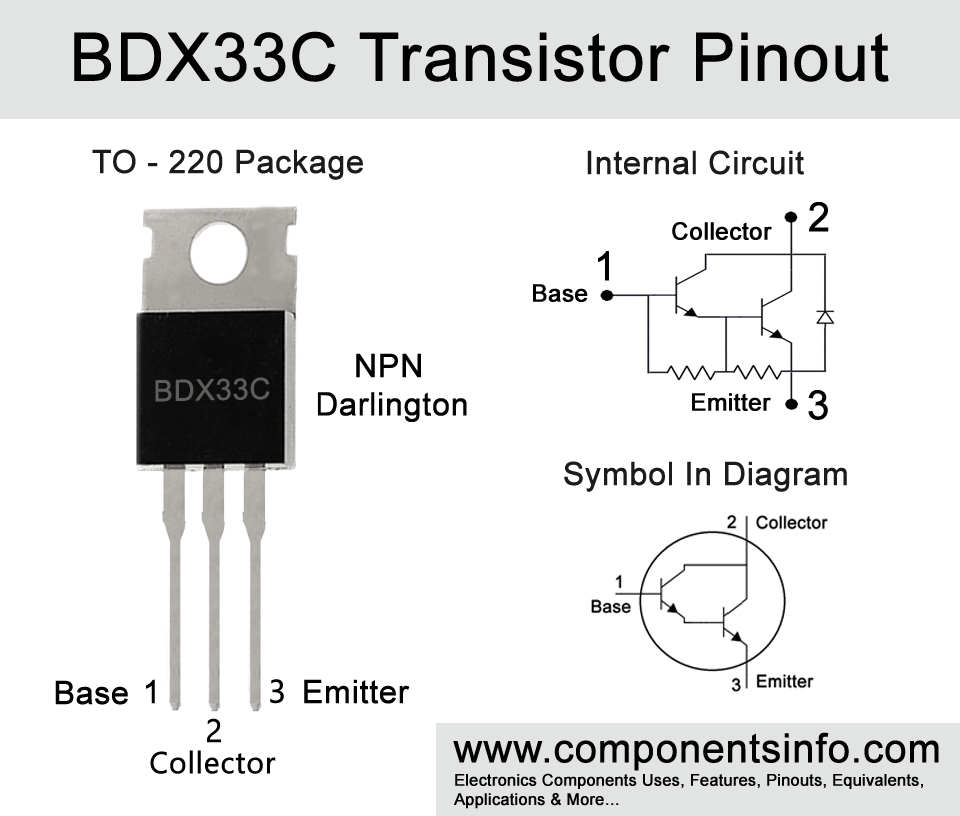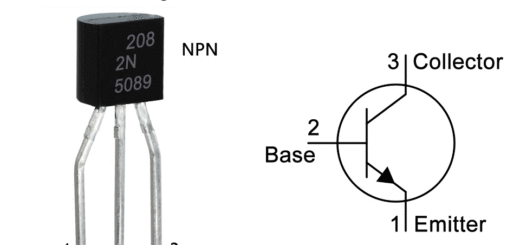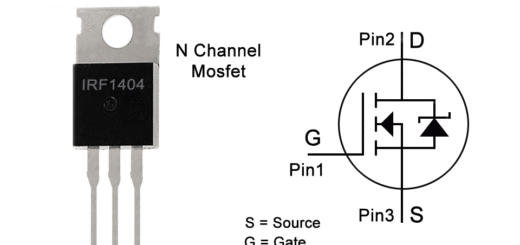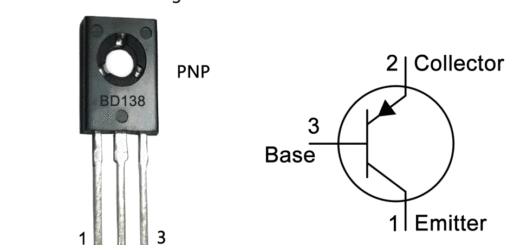BDX33C Transistor Pinout, Equivalent, Applications, Features and Other Important Info
BDX33C is an NPN darlington power transistor available in TO-220 package. Today we are going to discuss BDX33C transistor pinout, equivalent, applications, features and other important info.
Absolute Maximum Ratings:
- Package Type: TO-220
- Transistor Type: NPN Darlington
- Max Collector Current(IC): 10A
- Max Collector-Emitter Voltage (VCEO): 100V
- Max Collector-Base Voltage (VCBO): 100V
- Max Emitter-Base Voltage (VEBO): 5V
- Max Collector Power Dissipation (Pc): 70 Watt
- Minimum DC Current Gain (hFE): 750
- Max Storage & Operating temperature: -65 to +150 Centigrade
PNP Complementary:
PNP Complementary of BDX33C is BDX34C
Replacement and Equivalent:
NTE2343, MJF6388, BDW93C, BDW42, BDW43, BDT63C
BDX33c Transistor Explained / Description:
BDX33C transistor is a good choice if you require a Darlington power transistor for your general purpose applications. The maximum collector current of the transistor is 10A and the maximum collector to emitter voltage is 100V. The maximum collector current shows the maximum load this transistor is capable of driving and the maximum collector to emitter voltage shows the maximum voltage of the load this transistor is capable of handling.
It is a Darlington transistor which means the transistor contains two internal transistors which are connected in such a way that increases the gain of the transistor to a great extent. Looking at the pin configuration of the transistor, from the front side (Part Number Side) the first pin of the transistor is “Base”, second pin is “Collector” and the third pin is “Emitter”.
Now understanding the absolute maximum ratings of the transistor, the maximum collector current of the transistor is 10A, max collector-emitter voltage is 100V, max emitter-base voltage is 5V, max collector-base voltage is 100V and max collector power dissipation is 70 Watt.
Where We Can Use it & How to Use:
BDX33C is designed to use in switching and power linear applications but it is not only limited to these applications and can also be used in a wide variety of general purpose amplification, driver, and other applications.
To operate the transistor it is essential to know its pinout first and what are the requirements of the load you want to drive. After that connect the Emitter of the transistor with the negative supply of the circuit, then connect Base with the signal source of the circuit that you want to use as a switching signal or want to amplify that signal. Moreover, it is also important to use some passive components to build your amplifier circuit better.
Applications:
Switching Circuits
Audio Amplifiers
Pulse Generator
Motor Control
LED Drivers
Voltage Regulation
DC to DC Converters
Voltage inverters
Battery Operated Applications
Safe Operating Guidelines:
To safely operate the transistor follow these guidelines.
- One of the main thing to follow when it comes to safely operating the transistor is not to use it to its absolute maximum ratings. And stay 20% below from its max ratings.
- Now according to using it 20% below rule, the transistor’s max collector current is 10A so we will not drive load of more than 8A.
- And the maximum collector to emitter voltage is 100V so we will not drive the load of more than 80V.
- Moreover, the storage and operating temperature of the transistor should also be maintained between -55°C to 150°C but it will not be a problem because our atmospheric temperature will always stay between these limits but in situations when there are chances of your circuit to expose in extreme temperature conditions then you have to maintain the temperature of the transistor’s surroundings between these limits.
Datasheet:
To download the datasheet just copy and paste the below link in your browser.
https://datasheetspdf.com/pdf-down/B/D/X/BDX33C_FairchildSemiconductor.pdf



